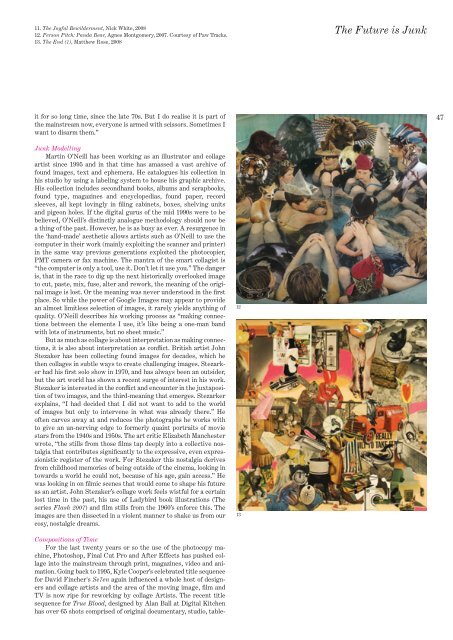THE FUTURE IS JUNK - paul burgess
THE FUTURE IS JUNK - paul burgess
THE FUTURE IS JUNK - paul burgess
Create successful ePaper yourself
Turn your PDF publications into a flip-book with our unique Google optimized e-Paper software.
11. The Joyful Bewilderment, Nick White, 2008<br />
12. Person Pitch: Panda Bear, Agnes Montgomery, 2007. Courtesy of Paw Tracks.<br />
13. The End (1), Matthew Rose, 2008<br />
it for so long time, since the late 70s. But I do realise it is part of<br />
the mainstream now, everyone is armed with scissors. Sometimes I<br />
want to disarm them.”<br />
Junk Modelling<br />
Martin O’Neill has been working as an illustrator and collage<br />
artist since 1995 and in that time has amassed a vast archive of<br />
found images, text and ephemera. He catalogues his collection in<br />
his studio by using a labeling system to house his graphic archive.<br />
His collection includes secondhand books, albums and scrapbooks,<br />
found type, magazines and encyclopedias, found paper, record<br />
sleeves, all kept lovingly in filing cabinets, boxes, shelving units<br />
and pigeon holes. If the digital gurus of the mid 1990s were to be<br />
believed, O’Neill’s distinctly analogue methodology should now be<br />
a thing of the past. However, he is as busy as ever. A resurgence in<br />
the ‘hand-made’ aesthetic allows artists such as O’Neill to use the<br />
computer in their work (mainly exploiting the scanner and printer)<br />
in the same way previous generations exploited the photocopier,<br />
PMT camera or fax machine. The mantra of the smart collagist is<br />
“the computer is only a tool, use it. Don’t let it use you.” The danger<br />
is, that in the race to dig up the next historically overlooked image<br />
to cut, paste, mix, fuse, alter and rework, the meaning of the original<br />
image is lost. Or the meaning was never understood in the first<br />
place. So while the power of Google Images may appear to provide<br />
an almost limitless selection of images, it rarely yields anything of<br />
quality. O’Neill describes his working process as “making connections<br />
between the elements I use, it’s like being a one-man band<br />
with lots of instruments, but no sheet music.”<br />
But as much as collage is about interpretation as making connections,<br />
it is also about interpretation as conflict. British artist John<br />
Stezaker has been collecting found images for decades, which he<br />
then collages in subtle ways to create challenging images. Stezarker<br />
had his first solo show in 1970, and has always been an outsider,<br />
but the art world has shown a recent surge of interest in his work.<br />
Stezaker is interested in the conflict and encounter in the juxtaposition<br />
of two images, and the third-meaning that emerges. Stezarker<br />
explains, “I had decided that I did not want to add to the world<br />
of images but only to intervene in what was already there.” He<br />
often carves away at and reduces the photographs he works with<br />
to give an un-nerving edge to formerly quaint portraits of movie<br />
stars from the 1940s and 1950s. The art critic Elizabeth Manchester<br />
wrote, “the stills from those films tap deeply into a collective nostalgia<br />
that contributes significantly to the expressive, even expressionistic<br />
register of the work. For Stezaker this nostalgia derives<br />
from childhood memories of being outside of the cinema, looking in<br />
towards a world he could not, because of his age, gain access.” He<br />
was looking in on filmic scenes that would come to shape his future<br />
as an artist. John Stezaker’s collage work feels wistful for a certain<br />
lost time in the past, his use of Ladybird book illustrations (The<br />
series Flash 2007) and film stills from the 1960’s enforce this. The<br />
images are then dissected in a violent manner to shake us from our<br />
cosy, nostalgic dreams.<br />
Compositions of Time<br />
For the last twenty years or so the use of the photocopy machine,<br />
Photoshop, Final Cut Pro and After Effects has pushed collage<br />
into the mainstream through print, magazines, video and animation.<br />
Going back to 1995, Kyle Cooper’s celebrated title sequence<br />
for David Fincher's Se7en again influenced a whole host of designers<br />
and collage artists and the area of the moving image, film and<br />
TV is now ripe for reworking by collage Artists. The recent title<br />
sequence for True Blood, designed by Alan Ball at Digital Kitchen<br />
has over 65 shots comprised of original documentary, studio, table-<br />
12<br />
13<br />
The Future is Junk<br />
47


